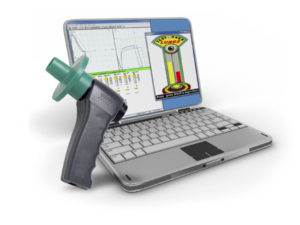Spirometry: Lung Function Testing
 Spirometry, or lung function testing, measures airflow rates and lung volumes of air going in and out of the lungs. A spirometer is a device that contains a special sensor behind the mouthpiece and is typically connected to a computer providing measurements of airflow. Spirometry is critical in the diagnosis and following of asthmatics or any patient with lower respiratory complaints.
Spirometry, or lung function testing, measures airflow rates and lung volumes of air going in and out of the lungs. A spirometer is a device that contains a special sensor behind the mouthpiece and is typically connected to a computer providing measurements of airflow. Spirometry is critical in the diagnosis and following of asthmatics or any patient with lower respiratory complaints.
Spirometry Testing
During spirometry testing, the patient will typically perform the test at least three times to achieve the best result. Once all of the air is expelled from the lungs, the patient will inhale as deep a breath as possible so that the lungs are completely filled with air. The patient will then exhale as hard and as fast as possible into the mouthpiece until a certain amount of time has elapsed. Then the patient will breathe in as deeply and as long as possible so the lungs are again filled with air.
Testing Results
Based on the shape of the inspiratory and expiratory curves produced during the testing, spirometry testing reveals critical aspects of airflow to the patient’s lungs. The testing provider can explain certain causes for lower respiratory complaints and design a treatment program accordingly.
